

download the entire series of chapters in zip file


Join The energy 21 newsgroup for more information when at hand
OLAF ROEMER'S EXPERIMENT
OLAF ROEMER'S conclusions regarding the speed of light certainly appear to be false. This Danish scientist noted that the eclipse of Jupiter's satellite lo always took place slightly later than the predicted time.
Having taken note of the time of the eclipse when the Earth was in opposition to Jupiter, he calculated the exact time at which a subsequent eclipse should occur, 200 days later, when the Earth went into conjunction with Jupiter. His actual observations showed that the eclipse took place approximately 1000 seconds later than predicted.
On the basis of Galileo's ideas, who postulated a speed of light, he calculated that this retardation must be due to the time that light took to travel across the diameter of the Earth's orbit. Taking this diameter as 300 million km. he merely divided this by the 1,000 seconds retardation and arrived at a figure of 300,000 km. per second for the speed of light.

Fig. 8 shows the position of the planets concerned at that time.
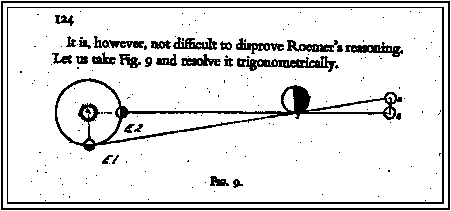
FIG. 9.
It is, however, not difficult to disprove Roemerr's reasoning. Let us take Fig. 9 and resolve it trigonometrically.
Let us suppose that the Earth was in position E.1 in its orbit at the time of the first eclipse. If we take its position at E.2, we will see that the eclipse will already have taken place so that an observer at E.1 will note a delay in the time of the eclipse, and at E.2 an advance. The time difference observed can be mathematically shown as follows:
Distance Sun E.1 = 149,000,000 km.
Distance Sun Jupiter = 780,000,000 km.
Distance Jupiter I0(a) = 400,000 km.
Distance Jupiter IO(b) = 400,000 km.
allowing for trigonometric corrections due to lines of sight passing 70,000 km. from centre of Jupiter.
We then get the following:
Distance Sun/E1
----------------------- = 0.1910
Tan Distance Sun/Jupiter
Distance Jupiter/Io(a)
------------------------- = 76,400 km
Tan Distance Io(a)/Io(b)
Io's velocity in orbit around Jupiter is 20.67 km. per second, we can therefore see that the difference in time between a sighting from the Earth in position E.1 and from the position E.2 is:
76,400 km.
-------------- = 3 696 seconds
20.67 km. per second -
This means that a movement of the Earth in its orbit through 90 degree
causes a time difference in an eclipse of Io of 3696 seconds.
When Roemer reached the conclusion that there was a retardation due to the speed of light, the Earth had, at that time, moved through 197degree 122 degree in its orbit. Seeing that the Earth had moved in its orbit from position A to position B (Fig. 10) in this time, we can, for the purpose of trigonometry, consider it to have reached point C, which gives a difference of only 17.12 degree between position A and position C.
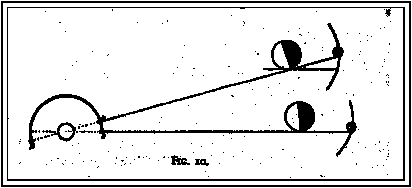
Fig. 11 shows how points in an orbit can be projected on an
exterior point. On this scale,90 degrees corresponds to 100 per cent,

17 degrees corresponds to 29 per cent. Using this as a basis for the calculation, we get
3,696 seconds X 29
-------------------- = 1,071 seconds
100
There is a difference between our calculations and Roemer's of 71 seconds because we do not know the exact position of Jupiter when the eclipse took place. Eclipses of Jupiter and Io take pLace every 42 hours 28 minutes 33 seconds.
It is possible that Roemer based his calculations on an observation after or before the eclipse, and any variation would alter the result. Further, the data we are using are approximate. Jupiter may have been nearer or farther away from the Earth. Neither can we be sure that Io's distance from Jupiter is constant, as in the case of our Moon, where the distance varies as much as 42000 km. Any of these factors may have accounted for the difference.
But in any case the retardation noted certainly exists, but is not due to the speed of light, but due to an optical effect which can be clearly illustrated by trigonometry.
We do not entirely deny that light has a certain speed at which it moves through space, we are merely pointing out Roemer's false assumptions which science has not troubled to revise, even though much research has been put into it since Roemer's day.
The fact is that no one would have thought it possible for a great personage to have made an error of trigonometry, especially as he was considered infallible. Right or wrong they accepted his conclusions.
As Roemer's deductions are false, it would be difficult to see how the relativist theory of physics would have developed without them, as the speed of light was the cornerstone of the whole theory.
We do not guarantee the absolute correctness of our calculations, but we do maintain that the time of an eclipse is advanced or retarded according to the position the planets occupy in space, quite independently of the speed of light, if this exists at all. If it does exist then it must move through our system with a speed that makes it virtually instantaneous.
However, we must also consider that contrary to our analysis, anyone versed in astronomy could raise the objection that Roemer did not base his calculations on the apparent eclipse that Io undergoes every 42 hours, but on its real eclipse due to its entry into the penumbra that is formed on the face of-a planet opposite the Sun.
However, if this objection were raised, it would be equally inconsistent as the penumbra also alters its position as the planet moves in its orbit through space, as shown in Fig. 12.
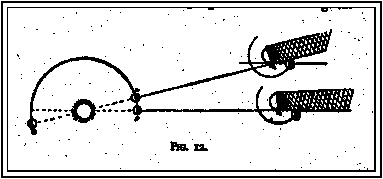
It is immaterial whether the lines Aji or CJ2 were lines of sight or were made by the light of the Sun, as both are the same. It is evident that Jupiter's continued movement in orbit would bring about a difference between a line of sight of an observer on Earth and that of the light of the Sun which makes the penumbra. In any case in Roemer's observations these lines coincide exactly and the variation amounts to 1,071 seconds,
The above illustration is only given to show the reader that a certain phenomenon may have various explanations with very divergent results. One cannot come to hasty conclusions without viewing the problem from all angles. It is not the intention to discredit the work of this famous scientist, who is worthy of our respect.
In the first edition of this book we refrained from inserting the full explanation of the captain's point of view. As the phenomenon of light and space is of fundamental interest to the whole of physics, and can even be considered the keystone to all science, we enlisted the opinion of various European universities and some famous physicists.
Where we first mentioned Roemer's calculations to the captain of the flying saucer, he stated he was not conversant with his theory, but gave us various explanations of the possible traps that Roemer could have fallen into. His views are given in the following pages.
_________________________________________________________________________________________
Q: It is a pity that you cannot give a full explanation of this phenomenon as this would be of great value to us. To take a concrete example: on the basis of the phenomenon observed by Olaf Roemer, science ceased to believe in God. The scientists reasoned as follows:
They say that God is light, or akin to light. But if there is a time lag in the movement of light through space, then light cannot be said to be ubiquitous; God could therefore not be omnipresent since He would need time to get from place to place. Then, as there could be no real God subject to time and space, they concluded that He did not exist. If He is not omnipresent, it must be because He is finite rather than infinite and could not therefore sustain the Universe. No finite principle could be God.
This is, succinctly, the reasoning behind scientific materialism. If it is your wish to make us believe in God, you will never achieve this without a clear analysis of the principles that science has espoused. It is, indeed, not strange that you are not familiar with Roemer's calculations, because he never published them. It is said that after his death, his work was virtually destroyed and only came to be known through one of his friends publishing his findings.
However, the details on which science bases its conclusions are known to me, and I can quote them from memory. Perhaps if we examine these, we could arrive at a definite conclusion on which you can give your opinion.
A: (after having studied the mathematical background).
In the light of your information I can now give you a rapid review of the question. Let me have some sheets of paper and I will draw some diagrams by way of explanation. Let us look at the following diagram:
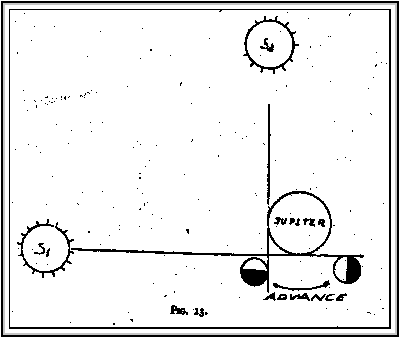
If the Sun were to revolve round the planets instead of vice versa, and if we noted the time of an eclipse with the Sun in position as S.1, and again in position S.2, we would note an advance in the time of the eclipse. That is, in position S.2 the eclipse would already have taken place. Now try and follow the reasoning very carefully.
The phenomenon is, however, unaltered by the fact that Jupiter revolves round the Sun. I do not know whether this comes in the scope of the "rational mechanics" on Earth, but there is a principle which states that all bodies moving in an orbit are subject to advance or retardation depending on the position they occupy in space.
Let us see how this operates with the aid of another diagram:
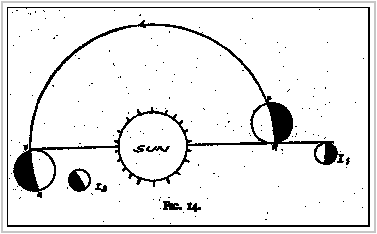
The horizontal lines represent the "line of sight" observation of the eclipses having regard for the direction of the planet's movement in orbit which in this case is anti-clockwise. The point at which this line of sight makes a tangent to the planet we will call A.
In this case we have to presuppose the existence of an equatorial diameter which is not included in your calculations. This is shown in the diagram as the line AF.
Note that in the case of the first eclipse the line of sight made a tangent to the planet at A, and in the case of the second eclipse it made a tangent at F.
The difference, therefore, is equal to the equatorial diameter, or in other words, the diameter of Jupiter. Note again that in the first eclipse lo was in position L1, and farthest away from the Sun, whereas in the case of the second eclipse it was in position L2 and between the Sun and Jupiter. Now we begin to see the reasons for the time lag which you maintain is due to the limited speed of light by which you try to banish God from the Universe.
To begin with, we do not know the exact distance of Jupiter from the Earth at the time of the eclipse. I will also take this opportunity to call your attention to a mistake made by astronomers which has a considerable bearing on the dimensions of the Universe, as we shall see later.
According to the astronomical data we have here, Earth should have moved through 197.122 degree of its orbit in 200 days, taking its mean sidereal day as O.98561 degree . Then deducting 1800 we are left with 17.122degrees, which, for the purposes of calculation, brings the planet back into its position of opposition.
In this time, Jupiter, with a mean sidereal day of only 0.08309 degree would have moved through 16.618, but this does not make sense, as with both planets moving in the same direction, there should be no difference in the angle at which Jupiter is seen from the Earth.
Now let us take this angle as a starting point; in 2oo days Io will have completed 113 revolutions of the planet. Yet Roemer could not have seen an eclipse either at the exact time of opposition or of conjunction, as the angle of sight was not wide enough to allow him to see this, He must have seen it happening before opposition and after conjunction. As the satellite completes 113 revolutions in 200 days, two further eclipses will bring it to 115,thus making the number of days to 2031/2. The angle that Jupiter moves through between opposition and conjunction with the Earth is 17.122degree. This would vary slightly in perihelion or aphelion due to the difference in speed brought about by the pressure of sunlight.
Jupiter's mean sidereal day is in the region of 0.08561 degree, with the corrections that we have made, so that if we add 3 1/2 days we would get a total of 17.47 degree. Let us say 17.45d egree to simplify the calculation.
If we can accept these figures, we can make a further diagram:
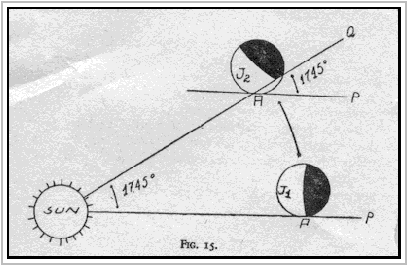
We saw that in Fig. 14 a movement of i80 degree of the Earth in its orbit will have brought about an inversion of the points at which the line of sight makes a tangent to the planet. In the first position the line touches A and in the second, 180 degree later, at F. But this inversion takes place slowly as the planet moves through space. Thus it is that with only 17.45 degree of movement the line of sight AP moves round to AQ, since we made it intersect exactly at point A. In this case the line AQ cuts through part of the planet forming an arc. The retardation occasioned by the movement of 17.45 degree will be found to be equal to this arc.
We now only need to see how to do the calculation with the aid of a further diagram.
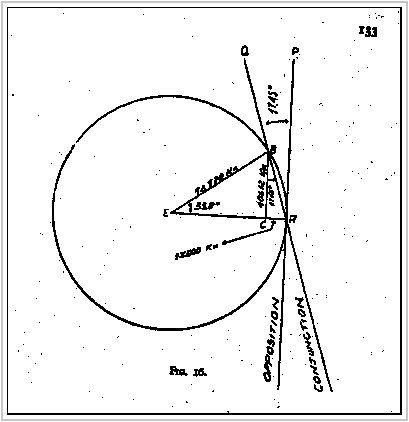
FIG. 16.
We can work this out by various means but we have adopted the one which is most easily shown graphically. We can now see how the phenomenon takes place. The line AQ determines a point of intersection on the circumference of a planet, which we shall call B. From this point we make a line from the circumference to the centre at E. EB is then equal to the equatorial radius of Jupiter and is the same as EA. From point B we draw a line at right angles to EA which will meet the latter at C. The retardation of the planet after moving through ~7.45 degree will therefore equal the distance AC.
Let us further work out what this distance represents in time. The angle EB EA is 33.80 or sin 0.558 the angle BC BA is 17.45 degree or tan 0.32O1.
Equatorial radius of Jupiter = EB = BA
Sin EB =BC
Tan BC = AC = 13000 km.
Having established the distance AC as 13,000 km., we now only need to convert this into seconds. Jupiter moves in its orbit at a speed of 13 km. per second.
13,000 km.
----------- = 1,000 seconds
13 km./seconds
Roemer observed a time difference of 1,000 seconds, which we also found. He attributed this to the time that light takes to cover the distance across the Earth's orbit; we have shown that this extraordinary hypothesis which led scientists to banish God from the Universe has a perfectly simple trigonometrical explanation. It was excusable for him to have made a mistake, because we all make plenty, but it is the conclusions which have been drawn from it which are not so excusable.
This would be more than sufficient to demonstrate the irrationality of Earth's people when they speak of a speed of light, and when they use this to support their materialist theories of limitation and curvature of space. But let us continue the reasoning and see whether our calculations are accurate.
When Jupiter was in position J.I and the Earth in opposition, the points ABC all coincided at point A, but when the planet had moved to position J.2 these points were moved as the line AP proceeded to form the line AQ. If we were to move the planet gradually back from the position J.2 through the ~7.45 degree that it had covered, we would see that the line AQ would eventually become the line AP, and that the points B and C would move closer together until they coincided at point A.
In the next figure we can see the variations of the movement of the equatorial axis we mentioned.
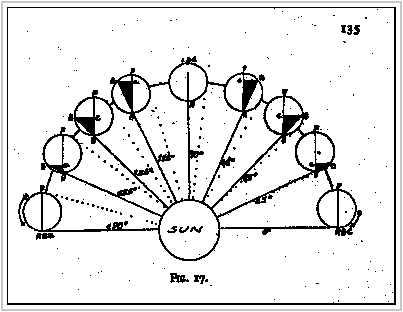
Fig. 17.
At the starting point 0 degree, points AB and C coincide and the line of sight is at right angles to the equatorial axis AF. As the planet moves so do points B and C, making a triangle whose area increases in relation to the angle the axis makes to the Sun. At 45 degree the distance between A and B is at a maximum and begins to decrease again until the 90 degee position, but the line AC continues to lengthen which means that the time noted for the eclipse will be changed very little. At the 90 degree position it will be seen that B and C coincide completely at F, when the relative time difference will be equal to the equatorial axis or diameter.
From that position to the 180 degree position, the position of points B and C is inversed and they again move towards point A; point B again moving round the circumference towards point A. We also notice that in this phase the triangle formed by ABC is on the opposite side of the baseline AF. At the 180 degree position, points ABC are again coincident. However, the time difference is equal to that of the diameter of the planet, as the line of sight of an eclipse must now pass through point F and no longer through point ABC, as was the case with the planet in the 0 degree position.
Having shown this, it would be easy to check the diameter of Jupiter and in consequence the optical problem. Let us proceed as follows (see Fig. 16):
If the line AC 13,000 km. the diameter of the planet will be
13,000 km.
------------ =40,612 km. = BC
0.3201
where 0.3201 tan angle BC BA
BC __ 40,612
Sin = EB =72,780km
EB - 0.558
Having obtained the equatorial radius of Jupiter, you can compare this with the radius obtained by optical measurement, and you will find a percentage difference between the two. This would be due to the defraction of light as in the case of the Sun appearing larger at sunrise or sunset than it does at midday. This is why I told you beforehand what I based my calculations on, to avoid contradicting terrestrial mathematics. Thus it is that the mass and the volume of Jupiter are not exactly those given by you.
If Jupiter unwittingly contributed to the establishment of scientific materialism on Earth, what we have now shown may well mean that she will be able to supply the proof of the error of existing theories. We have seen that, like other planets, its speed of axial rotation is equal to its velocity in orbit. This axial rotation, which you have not thought of, explains the peculiarities of Mercury. Astronomers observing the planet on its equatorial plane have noted that it rotates once on its axis for each revolution in orbit, yet this is not the whole story.
It is the same effect as we saw in the case of Jupiter; science maintaining erroneously that light takes a certain amount of time to move through space. In the case of Mercury, science maintains equally erroneously that it revolves once on its axis for every revolution in orbit.
What happens is that Mercury has a very rapid axial rotation. This does not take place on the equatorial plane of the solar system, but at right angles to it. Mercury is really a satellite of the Sun and not, strictly speaking, a planet, because only satellites have this peculiarity.
Having put this detail right, we can go much further. We can disprove the theory of relativity and Planck's quantum theory. Planck observed radiation in dark bodies and finding no explanation for this in the wave theory of light, he established the quantum theory to show the discontinuity of energy. Roemer's fallacious theory of light lent him support.
Now an electron, as a wave form, is moved in an anti-clockwise circle. In this spiraloid movement it has a discontinuous wave surface rather like a spiral spring. The movement itself is not discontinuous, but only appears so by virtue of its spiralling movement. It also shows a magnetic phenomenon cancelling out the charge on one side which gives an observer the impression that the energy moves in jumps. Further, it is subject to the outcome of the difference of charge due to this magnetic effect, as well as the result of its rotation, behaving like a globe, as a planet does in relation to the Sun.
This is a rough resume of the quantum theory which physicists boast of. The whole thing is a misinterpretation of simple trigonometrical phenomena.
Before denying God on the basis of this reasoning they should ask the Father for insight as He is the only one who can reveal His secrets. No one will be able to penetrate the Universe with the support of only a very limited power of reasoning.
The Universe is a house with an owner, and nobody, however rational he may be, can enter without the owner's consent. Let them ask the owner to accompany them and show them the peculiarities and details of every room. They should not try to emulate the toad who, wishing to be like an ox, swallowed so much air that his stomach swelled up and burst.
Man will not achieve anything by breathing the air of complicated theories in the hope of increasing his stature. True growth is always accompanied by humility. Science is a majestic palace with a narrow, low doorway which is barred to the proud. Here only the humble find reward, and those without faith and humility towards their Creator find nothing but confusion.
The foregoing were the words of our informant showing us the changes on Jupiter which gave the impression that there was a time factor involved in the movement of light through space, whereas this, in fact, was due to a trigonometrical phenomenon.
For people who are used to dealing with mathematical problems this simple demonstration will be sufficient for them to draw their conclusions and to correlate the movement of the satellite. But as this book was written for the general public, who may not have had time to go deeply into these matters, we will endeavour to illustrate the movement of the satellite lo in the simplest possible manner.
The arc formed by the line AB in Fig. 16 should be equal to 42,422 km. In 200 days time, the line AP (see Fig. 18) will only touch the circumference at a tangent. However, the movement that a point in the circumference would undergo in this time is:
42,4.22
------------ _ = 21,211 km. = AM = BM
2
If the position of point A moves the above number of kilometres in 200 days, this means that point A moves at a speed of 106 km per day.
The speed of IO in space is high, but low in relation to the surface of Jupiter, that is to say that it has a lower angular velocity. Thus the speed of IO in relation to the speed of the surface of the planet is only 3 km. per second.
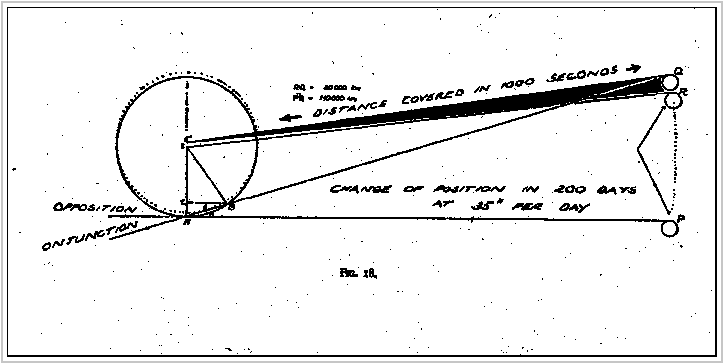
Let us now study Fig. 18 again. At the time of the observation at opposition Io must have been at point P. At the time of conjunction it must have been at point Q. In reality, however, 1,ooo seconds before the eclipse took place, it must have been at R, RQ representing the distance it moved in 1,000 seconds. In order to explain this, let us consider the following:
Science reckoned that Io completed a revolution in orbit every 152,913 seconds, that being the time required for the satellite to leave a point of reference and return to that same point again. The light of the Sun was taken as a reference point, by observing the exact moment which Io entered the penumbra. However, the light of the Sun, represented by the line AQ, moves at the rate of 106 km. per day. This change also changes the time of Io's movement through space, since the calculation of this movement is based on the line AQ. If the change in the surface of Jupiter is 106 km. per day, and if Io has a relative velocity of 3 km. per second, this means that the change brought about in the line AQ alters the timing of Io's observed movement by 35 seconds per day. Thus the true time of Io's revolution in orbit is 152,878 seconds and not 152,913 seconds.
At the rate of 35 seconds per day there will be a difference of 7,000 seconds in 200 days. If it moves in orbit at 20 km. per second, this will amount to 140,000 km., which is the distance between points P and R on Fig. 18. From this it will be seen that at the moment when the eclipse was expected to take place, Io was still at point R, it still had to cover the distance RQ before the eclipse could actually be seen.
Distance RQ is 20,000 km., and with a speed of 20 km. per second Io would move from R to Q in 1,000 seconds,
20,000
ie --------------
20 km./second.
Having shown this, one can conclude that light moves instantaneously through space. At a time when knowledge of astronomy was slight and when many people found it difficult even to believe that the Earth moved round the Sun, it would have been very difficult for Roemer to have arrived at a correct result.
With all its faults his work was admirable, taking into consideration the conditions under which he worked, the data at his disposal and the limited knowledge of his time.
Everything is, however, subject to the effect of uninterrupted progress, and changes as we move forward.
It would be folly to cling to theories, whether they be Roemer's or anyone else's, thereby trying to impede the progress of time and ideas that move like a river in flood, or to wish to put a limit to the understanding of phenomena like the cartographers of old who used to write on their maps at the Pillars of Hercules: Hic deficit orbis (Here ends the world). The theory of the speed of light is a modem equivalent to this attitude. However, the adventurous seamen of old were not deterred by these injunctions of their cartographers, who were the scientific elite of their times, and sailed onwards to discover a new continent.
In the great and wonderful unknown now awaiting discovery, the Universe will be revealed to you, no longer with limitations, but as infinitely great as its Creator. It is a mansion of infinite size which serves as a residence for an infinite God Who, wishing to show us the vastness of space, said: "The Heaven is my throne, and the Earth is my footstool: where is the house that ye would build unto me?" (Isaiah 66: i).
And we in our foolishness wish to build him a house to suit our ideas that are no larger than our small brains, as limited as relativity, and as cold and sepulchral as formulae. We made a coffin of the Universe and placed within it a mummified God. We inverted the process of creation and made a god of our image and likeness, circumscribed by the boundaries of a Universe which was limited only by our reasoning.

